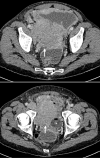Spontaneous Tumor Lysis Syndrome: A Rare Presentation in Plasmablastic Lymphoma
- PMID: 33643508
- PMCID: PMC7891912
- DOI: 10.14740/jh620
Spontaneous Tumor Lysis Syndrome: A Rare Presentation in Plasmablastic Lymphoma
Abstract
Tumor lysis syndrome is an oncological emergency, which can ultimately lead to death if not recognized early and treated accordingly. The institution of adequate prophylactic measures can decrease its incidence and severity; but very rarely, a highly aggressive neoplasm such as acute lymphoblastic leukemia or Burkitt's lymphoma can present with spontaneous tumor lysis syndrome (sTLS). We present the case of a 58-year-old male with newly diagnosed plasmablastic lymphoma with a retroperitoneal bulky mass invading the bladder, who presented with severe sTLS and was admitted to an intensive care unit due to acute renal failure and hyperkalemia requiring emergent renal replacement therapy. With urgent chemotherapy, several hemodialysis sessions and rasburicase, all the metabolic derangements were corrected and the patient fully recovered a normal renal function. This report highlights the importance of early recognition of sTLS in any patient presenting with severe and de novo multiple metabolic derangements involving uric acid, phosphorus, calcium and creatinine, even in patients with tumors not usually presenting with this complication.
Keywords: Dialysis; Plasmablastic lymphoma; Spontaneous tumor lysis syndrome.
Copyright 2021, Infante et al.
Conflict of interest statement
None to declare.
Figures



References
-
- Cairo MS, Coiffier B, Reiter A, Younes A, Panel TLSE. Recommendations for the evaluation of risk and prophylaxis of tumour lysis syndrome (TLS) in adults and children with malignant diseases: an expert TLS panel consensus. Br J Haematol. 2010;149(4):578–586. doi: 10.1111/j.1365-2141.2010.08143.x. - DOI - PubMed
-
- Jorge VM, Tiu A, Gupta S, Dourado C, Varadi G. Plasmablastic lymphoma in a community-based cancer center: a 10-year analysis of this rare disease in a underserved urban area. Blood. 2019;134(Supplement_ 1):5361–5361. doi: 10.1182/blood-2019-131905. - DOI
Publication types
LinkOut - more resources
Full Text Sources
Other Literature Sources
